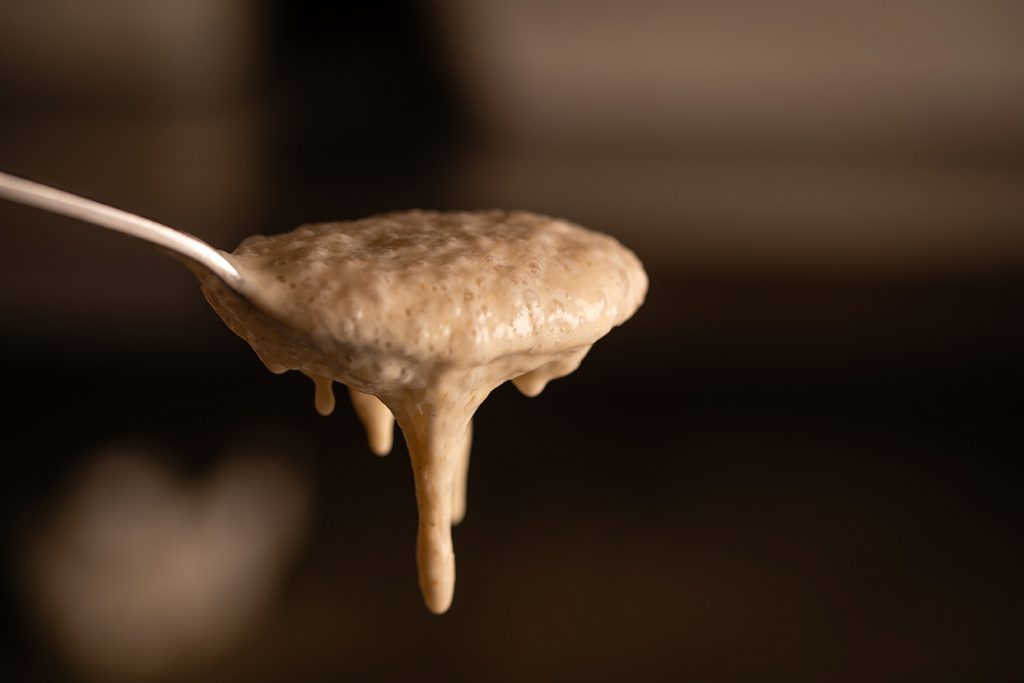
What is a sourdough starter and how does a simple mix of flour and water get to raise a loaf? Briefly put, there are two types of microogranisms in that jar of starter, both very important
- Wild yeast – it’s called wild, because, well, they are wild. Wild yeasts live on just about any surface around us, including grains and flour. What you are doing when you are making up a new sourdough starter is basically capturing these wild yeasts inside the jar. Yeast, as we all know, feed on sugars in the flour and produce carbon dioxide and that is what is eventually going to proof your doughs. That is why commercial yeast is no longer necessary when you are using a sourdough starter, because the proofing role is assumes by these wild yeasts instead.
- Lactic acid bacteria – it’s a bunch of bacteria which actually dominates the yeast in a sourdough culture and contributes to the flavor profile of your starter. Don’t worry, despite the name, they don’t have anything to do with milk nor do they contain lactose. What lactic acid bacteria does is feed on the carbohydrates in the flour and convert them into simple sugars, which are then consumed by the wild yeasts in order to produce carbon dioxide.
Your starter’s character
As these two live together in perfect harmony, a sourdough starter produces two types of acids, which are the main contributors to the flavor profile of your starter and your bread
- Acetic acid, which is why many sourdough breads taste slightly sour (no, sourdough is not supposed to taste very sour, there are actually sourdough breads which only have a hint of sourness or not at all sour). It smells like vinegar.
- Lactic acid
Every sourdough starter is different, they each have a different profile. Ideally you want your starter to smell like yogurt or something like this – so a bit sour, but not too heavily sour. If your starter smells extremely sour, it is very likely that if you use it for bread as is, you might get an overly sour loaf. It is a balance that is built over time, as you understand more and more about your starter, how often it should be fed, what types of flour it fares better with, what kind of temperatures render better results. Trust the process and the learning curve.
How to maintain a sourdough starter?
If you have successfully built a healthy starter (that means your starter is at least one week old and it doubles its volume in under 8 hours after feeding), now is the time to learn how to maintain it. If your starter doesn’t yet check both boxes mentioned above (it is either just a few days young or it doesn’t always double its volume in under 8 hours), don’t reach for the maintenance stage just yet, keep on feeding it in 1:1:1 ratios every 12hours until it is ready for the next stage. Remember, your starter is very fragile during these initial stages, so try and not kill it.
A recommended way of maintaining your starter (it is not the only one, of course, and in time you will figure out what suits you better), but if you have a new starter and relatively little experience with the matter you can proceed by feeding it in 1:3:3 ratios, or:
- One part starter
- 3 parts water
- 3 parts flour
That means that you keep 10 g of starter and you add 30 g of water and 30 g of flour. Or 20 g starter + 60 g water + 60 g flour.
You got this. A few things that are good to know before you embark on this journey.

You cannot avoid discarding starter, especially in the beginning, when this process is a great contributor to your starter being healthy and strong later on. Always weigh the starter you are using for feeding (the 1 part). You might be inclined to keep more than one part starter, after all what’s the big deal? The big deal is that you are sabotaging your starter by feeding it less than what it needs to thrive (by keeping 2 parts starter you have more starter to flour ratio, which means that your starter will be more hungry and more acidic). You can look up discard recipes, but also don’t be inclined to use more discard than the recipe calls for, if you don’t want sour waffles or pancakes.
Your starter’s behaviour depends on many factors. Don’t get frustrated if you don’t perfectly understand why your starter behaves a certain way right from the beginning, the starter you just created is a more complex beast than you might suspect and you both need time to get accustomed to each other. Trust the process.
- Feeding ratios – as your feeding ratios get smaller (that means the X in the 1:X:X is smaller), your starter will be more acidic and sour. As you increase your feeding ratios, the starter will have more food available and that will balance out the lactic and acetic acids, giving it a more palatable flavor profile.
- The flour you use to feed your starter will weight heavily on how the starter behaves. Some cereals have higher fermentation power (such as rye flour) and also remember that wholemeal flour generally ferments faster than white flour.
- The environmental temperature also makes a difference in how your starter behaves. Fermentation peaks at temepratures between 22 and 28 degrees. If you keep your starter in a cool place (e.g. refrigerator) you will see the fermentation is severely slowed (it still happens though, your starter is not dead). As you pass the 30 degrees Celsius mark, the wild yeasts in the starter begin to degrade, thus decreasing their proofing power and the wild yeasts die off at a temperature around 65C.

Brief summary:
Every starter is unique and its behavior is influenced by many factors, but a few are essential (feeding ratios, temperature, flour)
Only when you reach the point where tyour starter is stable and it doubles its volume in 4-8 hours, you can advance to the maintenance stage (we recommend 1:3:3 ratios every 12 hours, but of cours you have all the leeway in the world to decide what schedule and ratios work best for you)
You can keep your starter in the fridge if you don’t use it very often. You can simply feed it and keep it in the fridge until it has fermented, up to 2 weeks (sometimes even more). You will usually need to feed your starter a few times after it has been kept in the fridge to make sure it is very active before using it for breadmaking.
To maintain a starter and to make sourdough is nothing else than applied microbiology – that may sound difficult, but it’s really not. The best way to go about is to try and understand the process, not blindly follow recipes, that is the best way so that you can design your own flavorful recipes in time.
Ok, Ok, if you think about it, microbiology aside, there is a small miracle going on inside that jar, isn’t it?
